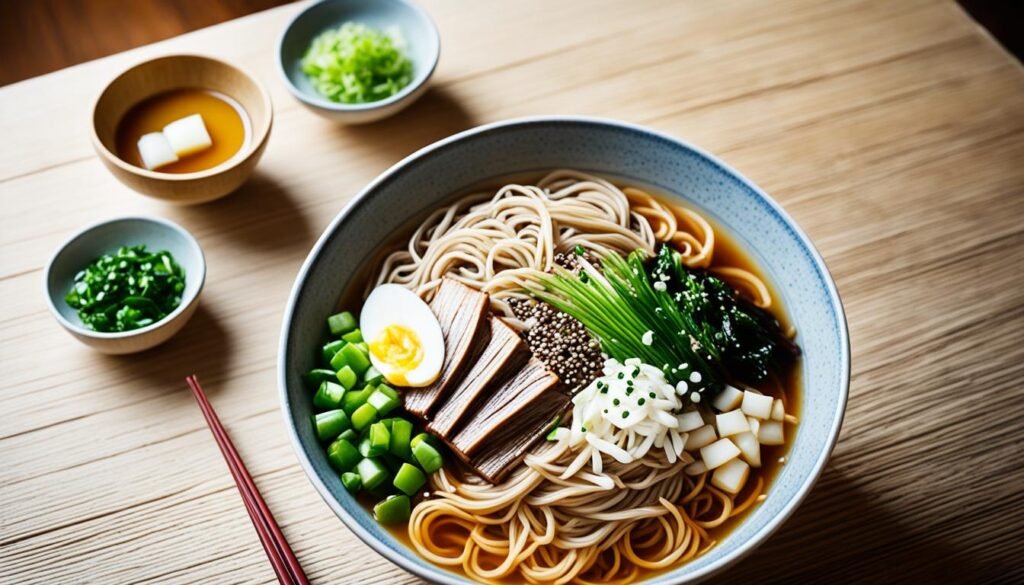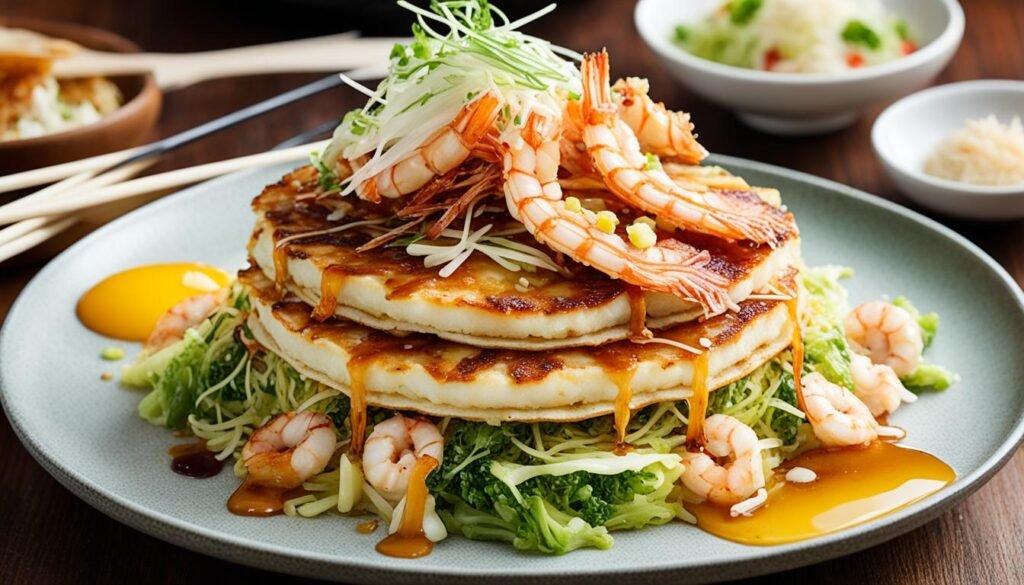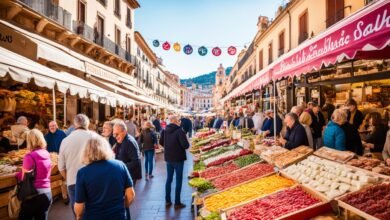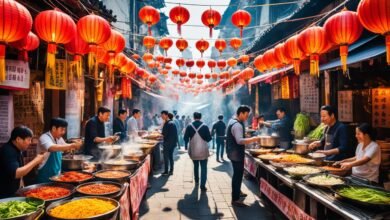Japan’s food scene is rich and varied, going well beyond sushi and ramen. Here, you can enjoy tasty sashimi and crunchy tempura. These dishes offer unique and delightful experiences for anyone seeking great food. This article will introduce you to 12 of Japan’s most essential foods, a must for all food lovers visiting the Land of the Rising Sun.
Whether it’s the fresh taste of sashimi, the heart-warming ramen, or the crispy tempura, Japan’s food is packed with treats. Discover the amazing flavors of Japanese cuisine. You’ll understand why it is loved all over the world.
Iconic Sushi and Sashimi: Japan’s Celebrated Raw Fish Delicacies
Sushi is raw fish on seasoned rice, a key part of Japan’s food. It started as a simple street snack. Today, it’s known for its range of tastes and textures. From the creamy uni to the plump amaebi, each piece tells a story.
Sashimi, thin slices of raw fish, is a palate cleanser. It comes at the meal’s beginning. This lets diners enjoy the fish’s natural taste.
The Art of Sushi: From Humble Beginnings to Culinary Masterpiece
The story of sushi goes way back. It began as fish kept in rice. Eventually, it became an art. The Japanese have perfected every aspect over the years. Chefs are known for their skills, making dishes both beautiful and tasty.
Sashimi: The Pure Essence of Fresh Seafood
Sashimi is the freshest raw fish, served first. It’s a dish that lets fish’s natural flavors stand out. Diners love the soft feel and gentle taste. It gets them ready for what’s coming next in the meal.
Ramen: Japan’s Soul-Warming Noodle Obsession
Ramen is a beloved dish in Japan, especially at night. It came from China but was adopted and transformed by the Japanese. Now, it features four main broth styles: tonkotsu, miso, soy sauce, and salt. Each part of Japan adds its own twist, celebrating the variety of this tasty meal.
Regional Ramen Varieties: Tonkotsu, Miso, and Beyond
Fukuoka is known for its creamy tonkotsu ramen, while Hokkaido offers pungent miso ramen. Tonkotsu is made by simmering pork bones for hours. It gives the soup a rich flavor. On the other hand, miso ramen from Hokkaido mixes bold miso with chewy noodles. Besides these, you will find soy sauce and salt-based ramens, each with unique flavors loved by fans.
Slurping Etiquette: Embracing the Sound of Satisfaction
In Japan, it’s okay, even good, to slurp your ramen. People believe the slurping cools down the noodles and spreads the flavors. This tradition is part of the fun of eating ramen. It’s about more than just the food; it’s about enjoying the whole experience.
Tempura: Japan’s Crispy, Light, and Delectable Fried Treats
Tempura is Japan’s gift to lovers of deep-fried foods. It’s a tasty dish made with batter-coated seafood and veggies. These are fried light and crispy in sesame oil. People enjoy them with soy sauce or salt for dipping. Don’t miss trying ebiten (tempura prawns) when you’re in Japan.
The magic of tempura’s light crunch comes from its batter and cooking method. The tempura batter is thin and carefully made. The chef uses fresh ingredients like tempura prawns and vegetables. Everything is fried until it’s a beautiful golden color.
Eating tempura is an experience. The contrast between the crispy outside and soft inside is amazing. This makes a meal of tempura truly special.
 Where can I find the best seafood restaurants in coastal cities?
Where can I find the best seafood restaurants in coastal cities?
Kaiseki: A Multisensory Exploration of Japan’s Haute Cuisine
Kaiseki is Japan’s high-end dining style. It began in Kyoto with the tea ceremony. Instead of a regular menu, it offers a series of small, beautifully arranged dishes. These plates highlight the best seasonal Japanese ingredients and the chef’s skill. Each dish reflects the current season, making it a full multisensory exploration of Japan’s culinary traditions.
The Art of Seasonal Ingredients and Exquisite Presentation
The essence of kaiseki is its use of fresh seasonal ingredients. Chefs show extreme care in how each dish looks. They pick the best and most flavorful seasonal ingredients. Then, they blend tastes, textures, and colors to create a visually beautiful spread.
A kyoto kaiseki is well-known for honoring traditional Japanese dining. Here, every part of the meal’s design adds to enjoying the Japanese haute cuisine. It truly offers a multisensory kaiseki culinary experience. This experience dives deep into Japan’s rich culinary history.
Soba: The Buckwheat Noodle Delight of Japan’s Mountains
Soba are long, thin noodles made from buckwheat. They’re a key part of Japanese food, especially in mountain areas. In these places, buckwheat thrives more than rice. This makes them a special dish to enjoy, bringing out their unique texture and flavor.
Hot or Cold: Savoring Soba’s Unique Texture and Flavor
Soba dishes can be served hot in a tasty soy sauce-flavored broth. They can also be served cold on a bamboo mat, with a side broth for dipping. Soba dining customs and soba specialties vary by region in Japan. They have deep roots in Japanese food culture, reflecting a genuine love for these amazing noodles.
Cold soba is a top choice for some. It lets people enjoy a mix of delicate flavors and textures without noodles getting too soft. On the flip side, eating hot soba warms the heart. The hot broth combined with the bouncy noodles is a treat.
Both hot and cold soba dishes play a big role in Japan’s food scene. They let food lovers enjoy the rich yet simple taste of this dish. It’s a must-try for anyone looking to dive into Japan’s food culture.

Shabu-Shabu: The Communal Cooking Experience
Shabu-shabu is a Japanese dish loved for how it brings people together. The name comes from the sound meat makes when swirled in broth. It’s a fun way to eat together, with each person cooking their food bit by bit.
Swishing Meat Slices in Bubbling Broth
In shabu-shabu, thin slices of meat are cooked in a hot broth. These slices are of top-quality beef or pork. Diners swish their meat around with chopsticks, letting it soak up the tasty broth. This swishing sound is why it’s called shabu-shabu.
Not just meat, shabu-shabu includes yummy greens, mushrooms, and even seafood. You cook these in the same broth, making it a shared meal. Everyone can add what they like and enjoy the experience together.
Shabu-shabu is about more than just eating. It’s the fun of cooking your food and sharing it. The hot pot bubbling in the middle of the table looks and smells amazing. It makes your meal feel like a special, unforgettable journey into Japanese cuisine.
Okonomiyaki: Japan’s Savory Pancake Indulgence
Okonomiyaki is a savory Japanese pancake. It’s called “grilled as you like.” It has won over people around the globe. This tasty treat is made with ingredients like cabbage and pork. It’s topped with fish flakes, dried seaweed, mayo, and a special sauce.
 Where can I find the best farm-to-table restaurants in the United States?
Where can I find the best farm-to-table restaurants in the United States?
Regional Variations: From Hiroshima to Osaka
Different parts of Japan have their own okonomiyaki style. For example, Hiroshima-style is layered. But Osaka-style mixes the ingredients with the batter. This gives each dish a unique taste.
The Fun of Grilling Your Own Okonomiyaki
In Japan, some okonomiyaki places let you cook your own. They have griddles at the tables. This makes eating okonomiyaki fun and personal. You get to make it just how you like and enjoy the show as it cooks.

Tonkatsu: Japan’s Beloved Breaded Pork Cutlet
Tonkatsu is a fried pork cutlet in breadcrumbs. It comes from the late 19th century in Japan, influenced by the West. Kurobuta or Berkshire pork from Kagoshima is famous for being very tender. It’s usually served with miso soup and a lot of cabbage.
Kurobuta: The Melt-in-Your-Mouth Berkshire Pork Experience
Kurobuta means Berkshire pork. It’s the best meat for tonkatsu because it’s soft and flavorful. With kurobuta, tonkatsu gets a crispy shell and soft inside. It’s a special treat for anyone who enjoys tonkatsu.
In Japan, tonkatsu is loved and well-prepared. It’s all about using top-notch kurobuta pork, a careful way to bread, and frying correctly. This makes the tonkatsu meal comforting yet fancy.
What are the must-try dishes in Japan?
Yakitori: Grilled Skewers of Chicken Deliciousness
Imagine this: a cold beer in hand and some yakitori, or charcoal-grilled chicken, skewers. It’s the go-to way to unwind for Japan’s working crowd during the week. The yakitori menu includes almost every part of the chicken. These are cooked perfectly and flavored with either shio (salt) or tare (sweet soy glaze). People love eating yakitori at an izakaya, a cozy Japanese gastropub. There, they can also try out various small dishes and drinks.
The Izakaya Experience: Beer and Yakitori Bliss
In Japan, the izakaya is a special place where friends and coworkers meet. They come to relax with cold beers and tasty yakitori skewers. These Japanese gastropubs are full of life and real. You get to enjoy the fun atmosphere while munching on grilled skewers. The mix of cold beer and yakitori sums up the amazing izakaya scene. It really showcases Japan’s love for good food and drinks.
Unagi: Japan’s Grilled Eel Delicacy for Summer Rejuvenation
Unagi, also known as river eel, is a favorite in Japan. It is typically grilled over charcoal and then glazed with a sweet sauce. Folklore tells us unagi is perfect for cooling down during Japan’s hot summers.
Its history runs deep in Japanese culinary traditions. Specialist restaurants often follow traditional methods. You can find Fresh, wild-caught unagi between May and October. This makes it a seasonal treat for anyone who loves good food.
Other Must-Try Dishes in Japan
Japan has many more dishes to try beyond the ones we’ve talked about. For example, there’s gyoza, or Japanese dumplings, filled with goodies like meat or vegetables. They can be cooked in different ways, like pan-frying or deep-frying. Then there’s miso soup, a soup made from fermented soybean paste. It’s a common part of Japanese meals and is often served with scallions and tofu.
Gyoza: The Delightful Journey of Japanese Dumplings
Delicious gyoza are a must-taste food in Japan. These Japanese dumplings come in many styles. You can find them hearty and boiled or light and pan-fried, called “yaki-gyoza.” They really show off gyoza’s variety.
Miso Soup: The Savory Staple of Japanese Cuisine
Miso soup is a key part of Japanese meals. This soup is made from fermented soybean paste. It’s often seen with tofu and scallions. It’s a tasty start to a meal.
 Which destinations are famous for their wine and food pairings?
Which destinations are famous for their wine and food pairings?
Wagashi: The Exquisite World of Japanese Sweets
Then there’s wagashi, pretty Japanese sweets made from plant ingredients. These include bean paste and mochi. They’re perfect with tea. Eating them is like enjoying edible art.
Udon: The Thick and Chewy Noodle Delight
And who can forget udon? These thick wheat noodles can be served hot or cold. They come with a tasty broth or a dipping sauce. Udon is a special part of Japan’s food scene, offering hearty bites.




